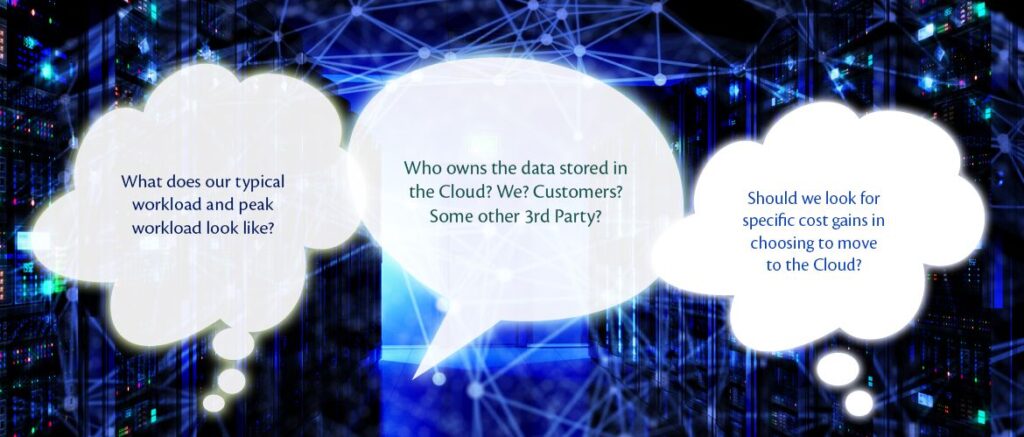What is Cloud Migration – in 94 seconds
Today, the most argued topic in a board room of any size is the role of Cloud computing in the success of their business. The decision makers need to equip themselves with the right information to do justice to this discussion.
The topic is multi-dimensional. Answers to some of these questions will help in addressing this need. CXO’s have to provide these answers to their boards. Most important ones are:
I. Relationship Between Cloud Computing And Our Business:
- Are we users or providers of Cloud-based products and services?
- What is the nature of information stored in the Cloud? Is it sensitive or public record?
- Who owns the data stored in the Cloud? We? Customers? Some other 3rd Party?
- Is our data secure enough within the Cloud as promised by the Cloud service provider?
- Are we fulfilling our compliance commitments by keeping our data in the Cloud?
II. Financial Implications Of Being In The Cloud:
- Should we move to the Cloud for the range of additional benefits that will accrue even if it is costlier?
- Should we look for specific cost gains in choosing to move to the Cloud?
- What kind of incremental investment and regular cash outflow is needed to support our Cloud strategy?
III. Operational Issues:
- What does our typical workload and peak workload look like?
- Do we need to provide for sudden bursts in our computing power for short durations?
IV. Choice And Flexibility:
- Are we likely to get locked-in with the Cloud Infrastructure Services Provider and become dependent on them?

But in the midst of all these strategic questions, there is one very important tactical question which every CXO must answer and that is…
- How easy is it to migrate existing applications and IT infrastructure to Cloud?
CXO’s Migration Strategy Must Ensure That:
- Business operations are not impacted by moving to Cloud
- Minimal or no code changes in existing applications
- Seamless transition of existing security architecture in the Cloud model
- Effortless integration with currently deployed network architecture
- Same or better I/O performance
- Compute node configurations match currently deployed servers
- Application performance is not impacted
- Speed of migration (or the lack of it) does not act as a deterrent to Cloud computing
Many businesses and their IT departments make the mistake of mixing up moving to Cloud and moving their dev teams to DevOps culture. The blogosphere is full of articles which suggest that in order to reap maximum benefit from the Cloud infrastructure service you must move to DevOps and that you must re-think your architecture. While it is definitely a good end-goal to have for some starting their journey, it is not something you would want to tackle from the get-go. Moving to Cloud-based infrastructure should not force you to re-think your existing architecture.
It is best to plan moving your infrastructure to the Cloud with minimal disruption so as to not upset the rhythm of day-to-day business and that of your existing teams. Deploying your business and operations to Cloud will not turn into an exercise of re-thinking your IT philosophy if you choose the right IaaS construct to migrate to.
In A Typical Corporate Data Center, You Would Find…
- Centralization of your organization’s IT operations & equipment
- Ability to deploy multiple servers and storage devices of varying configurations to support business-critical applications
- Switches, Routers, and cables to configure physical networks to enable separation of roles and responsibilities requirements set by your auditors
- Firewalls, IPS, and IDS to implement security zones
- Trained staff to monitor and maintain deployed infrastructure
Virtual Data Center (vDC) is one such product offered by some Cloud Infrastructure Services Providers which will enable the smooth transition of existing compute and network infrastructure to Cloud model. A rightly designed vDC offers all the features provided by its physical counterpart:
- Provisioning of virtual compute, storage, networking and security resources on demand
- Ability to configure networks to enable communication between deployed resources within vDC
- Capabilities to implement security and access restrictions
- Administrative capabilities to manage vDC in totality or in parts
- Monitoring & alerting capabilities for provisioned virtual resources
- Access to audit logs to meet compliance requirements set forth
For anyone considering migration from their existing data center to Cloud or thinking of consolidating various already deployed virtual machines in existing Cloud into a single, manageable, secure Cloud construct, Virtual Data Center (vDC) is the way to go. It is almost as easy as picking up Lego pieces from one table to rebuild on another — just-in-place replacement.
